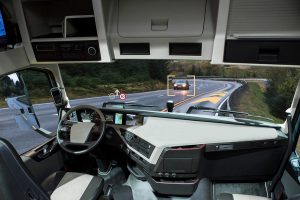What’s Driving the Truck Platoon Phenomenon?
 Truck platoons are gaining momentum with suppliers who are seeking safer and cheaper transportation alternatives to traditional semitruck tactics. In a truck platoon setup, a lead truck sets the pace for those closely following behind, benefiting from aerodynamics due to their close proximity. Proponents tout the safety and cost benefits of this follow-the-leader delivery truck approach, but skeptics want to know how it works and whether it’s actually safer and more fuel efficient.
Truck platoons are gaining momentum with suppliers who are seeking safer and cheaper transportation alternatives to traditional semitruck tactics. In a truck platoon setup, a lead truck sets the pace for those closely following behind, benefiting from aerodynamics due to their close proximity. Proponents tout the safety and cost benefits of this follow-the-leader delivery truck approach, but skeptics want to know how it works and whether it’s actually safer and more fuel efficient.
Drivers need not apply?
To realize the aerodynamic benefits of truck platooning, trucks must drive very closely together, making synchronized acceleration and braking necessary. This synchronicity requires electronic truck-to-truck communication, meaning these vehicles must operate at least semi-autonomously, allowing technology to handle — at minimum — speed and brake controls. Are drivers even necessary?
Although the idea of self-driving freight trucks may seem a bit unnerving, the reality is they’ve already been tested. Self-driving freight truck technology developer Otto has tested its self-driving trucks all over the country, traveling as much as 200 kilometers of Interstate 25 in Colorado in one test. And the Federal Highway Administration (FHWA) has conducted multiple truck platooning tests with automated driving systems and backup human drivers for just-in-case scenarios.
The idea of combining self-driving vehicles in a truck platoon setup is revolutionary in the freight arena as well as the logistics industry overall. But are the benefits really worth the research investment?
Truck platoon benefits
With fuel costs making up approximately one-third of long-haul trucking operation expenses, according to the MIT Technology Review article, along with traffic congestion, regulations, and safety concerns adding to the economic and logistics overhead, truck platooning could prove beneficial.
- With highly developed sensors and vehicle-to-vehicle communication technology, semi-autonomous trucks are purportedly safer because they don’t suffer conditions like distractedness, exhaustion, and momentary glances away from roads.
- Truck platooning saves the lead truck 4.5% in fuel costs, which goes up to 10% for the second truck in a two-truck platoon. And some studies have shown fuel savings as high as 21%.
- Platooning trucks drive so effectively and closely together that, according to the Supply Chain Digest article, it is essentially like removing trucks from the road, thereby reducing congestion.
- Semi-autonomous trucks would enable human backup drivers to rest and even nap during long hauls, meaning driver safety regulations would no longer apply and trucks could run 24/7, shortening delivery times and decreasing costs, according to the MIT article.
- Better fuel efficiency means a much smaller carbon footprint for the freight hauling industry, according to the 21st Century Supply Chain article.
The future is here
 Truck platooning seems to be something straight out of a science fiction movie, but this technology is being developed and tested around the world today — and for good reason. If semi-autonomous or fully autonomous freight trucks in a row can make logistics easier, safer, more fuel-efficient, less expensive, as well as greener and more sustainable, what’s not to like?
Truck platooning seems to be something straight out of a science fiction movie, but this technology is being developed and tested around the world today — and for good reason. If semi-autonomous or fully autonomous freight trucks in a row can make logistics easier, safer, more fuel-efficient, less expensive, as well as greener and more sustainable, what’s not to like?


